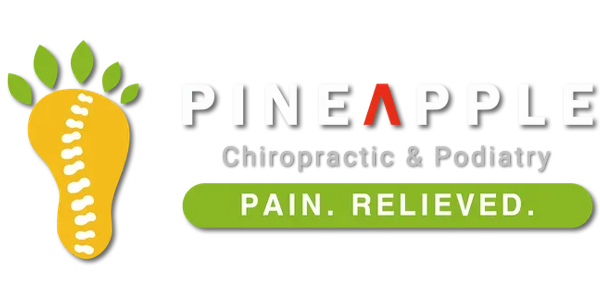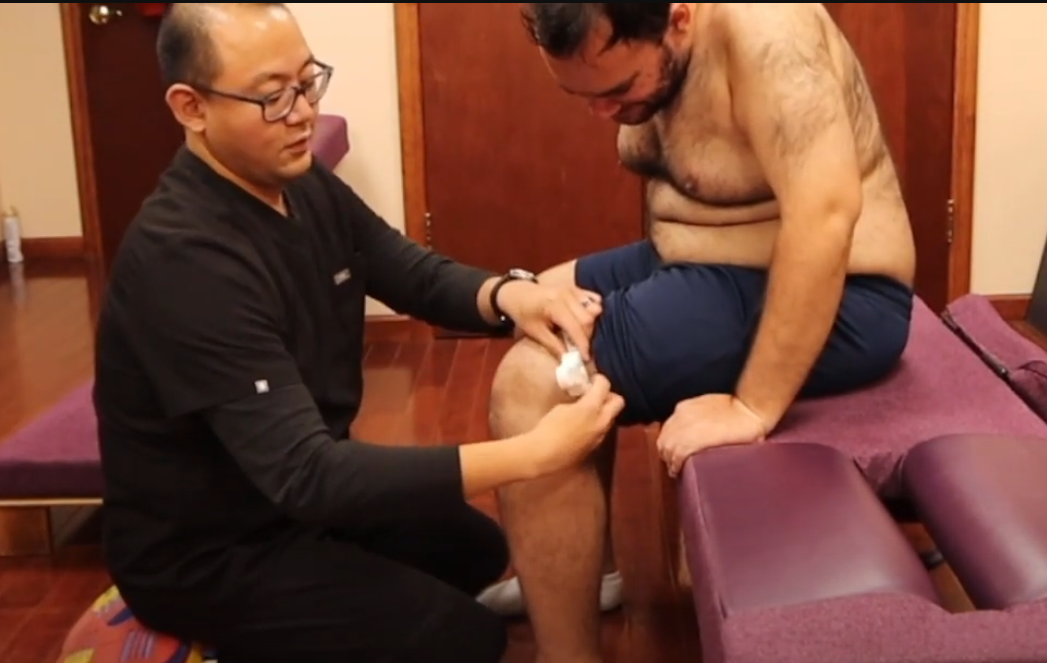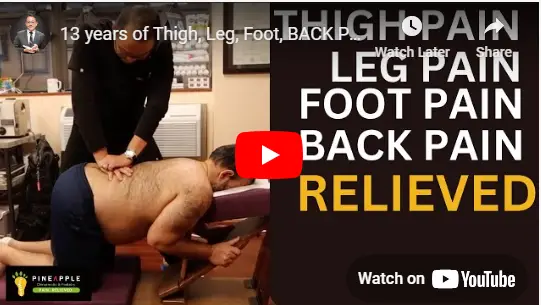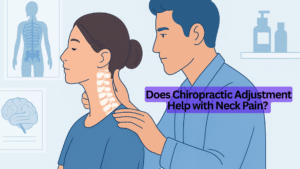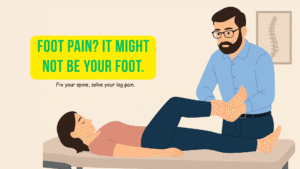Back pain affects millions of people worldwide. Finding the right treatment is essential for relief.
I am Dr. Hyunjae Lee, a board-certified doctor of podiatric medicine and a doctor of chiropractic. In my practice, it has proven that chiropractic care can be a valuable solution for back pain. As a chiropractor, I specialize in diagnosing and treating musculoskeletal issues, particularly those related to the spine. My approach often involves spinal adjustments and manipulations to alleviate pain and improve function. Understanding how chiropractors can help with back pain, the types of treatments available, and what to expect during a visit can be crucial for making informed decisions about your health.
This blog is based on my 20+ years of experience and explores how I treat back pain and provide insights into the benefits and risks of chiropractic care. Read on to learn how chiropractic care which I have seen in my practice might be the solution you need for your back pain.
What Kinds Of Conditions Does A Chiropractor Treat?
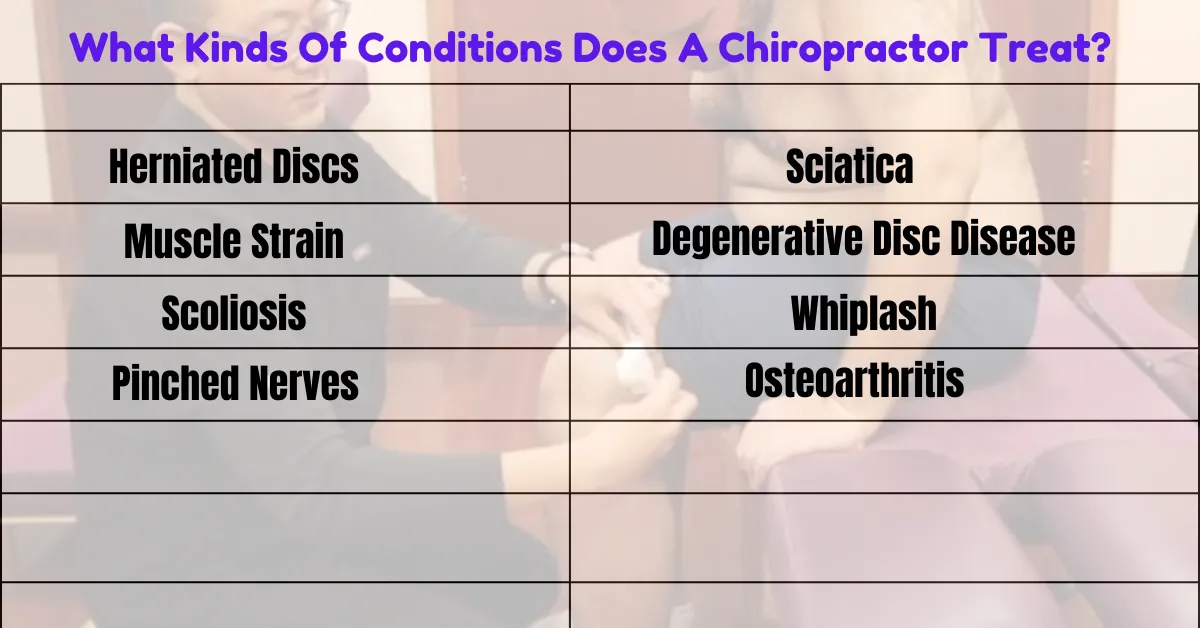
During treating various conditions, As a chiropractor, Dr. Lee identifies and addresses other aspects of the body (lower back, hips, knees) that frequently affect foot and ankle pain. To treat the foot and ankle properly, the whole body must be examined and treated, not only the problematic areas.
I’ve noticed, back pain can disrupt daily life and hinder activity. As a chiropractic specialist, I can help manage and treat various conditions causing this discomfort.
Herniated Discs
Herniated discs occur when the cushion between vertebrae slips out of place. This can cause intense pain and limit movement. I use specific techniques to relieve this pain and improve function.
Sciatica
Sciatica is another common condition I can treat. It involves pain radiating along the sciatic nerve, which travels down the legs.
- Symptoms: Include sharp pain, numbness, and tingling.
- Treatment: Chiropractors may use spinal adjustments and exercises.
Muscle Strain
Muscle strain is a frequent cause of back pain. Overuse, improper lifting, or sudden movements can lead to this condition.
- Symptoms: Pain, swelling, and muscle spasms.
- Treatment: Gentle adjustments and physical therapy.
Scoliosis
Scoliosis is a sideways curvature of the spine. It can range from mild to severe and may affect posture and movement.
I can help:
- Assess the severity: Through physical exams and imaging.
- Provide treatment: Including adjustments and stretches.
Degenerative Disc Disease
Degenerative disc disease happens as the discs in the spine wear down over time. This can cause chronic back pain.
- Symptoms: Pain that worsens with activity, stiffness, and reduced flexibility.
- Treatment: Spinal manipulation, exercises, and lifestyle advice.
Pinched Nerves
Pinched nerves result from too much pressure on a nerve by surrounding tissues. This pressure can cause pain, tingling, and numbness.
I can address this by:
- Identifying the source: Through examination and imaging.
- Relieving pressure: Using spinal adjustments and decompression techniques.
Whiplash
Whiplash often occurs due to car accidents or sudden impacts. This condition affects the neck and upper back, causing pain and stiffness.
- Symptoms: Neck pain, headaches, and limited range of motion.
- Treatment: Gentle adjustments, physical therapy, and exercises.
Osteoarthritis
Osteoarthritis is the wear-and-tear of joints, including those in the spine. This condition can lead to chronic pain and reduced mobility.
Chiropractors offer:
- Pain relief: Through spinal adjustments.
- Mobility improvement: With tailored exercises and stretches.
When Can A Chiropractor Help With Back Pain?
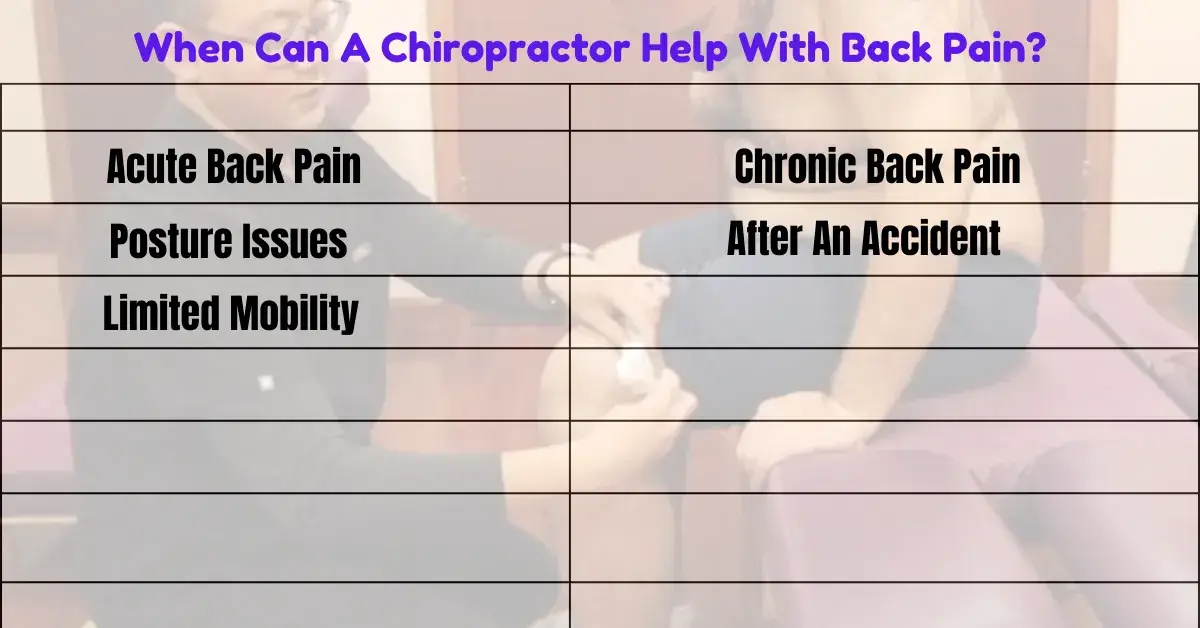
In my sessions, I can help with back pain caused by muscle tension, poor posture, or spinal misalignment. I use hands-on adjustments to relieve pain and improve mobility.
Back pain affects many people and can disrupt daily life. I am able to help. Understanding when to visit one can be crucial.
Acute Back Pain
Acute back pain is sudden and severe. I can help in these cases:
- Muscle strain: Chiropractors can ease muscle tension and pain.
- Sports injuries: They can provide relief and improve mobility.
- Sudden movements: If you hurt your back from a sudden twist or lift, they can assist.
Chronic Back Pain
Chronic back pain lasts for weeks or months. It can be constant or come and go. I can offer solutions for long-term relief.
Posture Issues
Poor posture can lead to back pain over time. I can correct posture problems:
- Sitting habits: Advice on proper seating and workstations.
- Standing posture: Techniques to stand correctly and reduce strain.
- Sleeping positions: Tips to maintain good posture during sleep.
After An Accident
After an accident, back pain might not appear immediately. I can help:
- Whiplash: They can treat neck and back injuries from car accidents.
- Falls: Treatment for injuries from slips and falls.
- Work injuries: Help with back pain from workplace incidents.
Limited Mobility
Limited mobility can result from back pain. I can enhance movement:
- Joint stiffness: Techniques to loosen stiff joints.
- Flexibility: Exercises and adjustments to improve flexibility.
- Pain relief: Reducing pain to allow better movement.
Preventative Care
I also help prevent back pain. Regular visits can keep your back healthy:
- Routine check-ups: Early detection of potential issues.
- Maintenance adjustments: Keeping your spine aligned.
- Health advice: Tips on diet, exercise, and lifestyle for a strong back.
Specific Conditions
Certain conditions require chiropractic care. Here are some examples:
- Sciatica: Pain from the lower back down the leg.
- Herniated discs: Bulging discs causing pain and discomfort.
- Osteoarthritis: Degeneration of joints in the spine.
Knowing when a chiropractor can help with back pain can lead to quicker relief and improved health.
What Types Of Chiropractic Treatments Do You Offer?
We offer spinal adjustments, soft tissue therapy, and rehabilitative exercises to alleviate back pain. Personalized treatment plans ensure effective pain relief and improved mobility.
Dealing with back pain can be challenging. During treatment, I offer various treatments to help you feel better. Here’s a look at some common chiropractic treatments.
Spinal Manipulation
Spinal manipulation is a popular chiropractic treatment. It involves adjusting the spine to improve movement and reduce pain. I use my hands to apply controlled force to the spine. This helps in relieving pressure on joints and improving overall function.
Soft Tissue Therapy
Soft tissue therapy focuses on treating muscles and ligaments. I use different techniques to ease muscle tension and improve blood flow. Here are some common methods used in soft tissue therapy:
- Trigger Point Therapy: Pressing specific points to relieve tight muscles.
- Myofascial Release: Stretching and loosening the fascia around muscles.
- Massage: Applying pressure to muscles to reduce tension.
Exercise And Rehabilitation
Exercise and rehabilitation are key components of chiropractic care. I design personalized exercise plans to strengthen your back. These exercises help in improving posture and preventing future injuries. Patients perform these exercises both in the clinic and at home.
Lifestyle Advice
Lifestyle advice is crucial for long-term back health. I provide guidance on daily habits and activities. Here are a few areas they focus on:
- Ergonomics: Tips on maintaining proper posture at work.
- Nutrition: Advice on foods that support back health.
- Stress Management: Techniques to reduce stress and its impact on your back.
Electrical Stimulation
Electrical stimulation is a modern chiropractic treatment. It uses electrical impulses to reduce muscle pain and inflammation. I place electrodes on the skin, which send gentle currents to the affected area. This helps in relaxing muscles and promoting healing.
What Are The Benefits And Risks Of Chiropractic Care?
In my sessions, chiropractic care can provide relief for back pain by realigning the spine and improving mobility. Some risks include possible muscle soreness and rare complications such as nerve damage.
Experiencing back pain can be debilitating. Chiropractic care offers a non-surgical option for relief. But what are the benefits and risks? Let’s dive in.
Benefits Of Chiropractic Care
Chiropractic care can provide numerous benefits for those suffering from back pain. Here are a few key advantages:
- Pain relief: Reduces discomfort and improves mobility.
- Non-invasive: Avoids surgery or medication.
- Personalized treatment: Tailored to individual needs.
- Preventative care: Helps stop future issues.
Risks Of Chiropractic Care
While chiropractic care is generally safe, it’s important to be aware of potential risks.
- Minor side effects: Temporary soreness or stiffness.
- Rare complications: Possible nerve irritation or disc injury.
- Not for everyone: Certain conditions may not benefit.
Holistic Approach
Chiropractic care often includes a holistic approach to health. It focuses on overall well-being, not just back pain.
Professional Guidance
Always seek professional advice before starting treatment. As a qualified chiropractor, I will assess your condition and recommend the best course of action.
What Should I Expect At My First Visit To A Chiropractor?
Expect a thorough examination and discussion about your back pain during the first visit to my chamber. I perform adjustments and provide advice on exercises to relieve your pain.
Visiting a chiropractor for the first time can be a bit daunting. Understanding what to expect can ease your concerns and help you feel more comfortable.
Initial Consultation
You’ll start with a discussion with me about your health. This helps me understand your condition.
- Health history: Details about past injuries, surgeries, and existing conditions.
- Current symptoms: Information on pain location, intensity, and duration.
- Lifestyle factors: Work habits, exercise routines, and daily activities.
Physical Examination
A physical exam follows the consultation. I will check your posture and spine.
- Posture check: Assessment of your standing and sitting posture.
- Spine alignment: Examination of spinal curvature and any misalignments.
- Range of motion: Tests to see how well your back moves.
Diagnostic Tests
Next, there may be some tests. These help me diagnose your condition.
- X-rays: Images to see bone structure and alignment.
- MRI scans: Detailed pictures of soft tissues and nerves.
- Reflex tests: Checking nerve responses and muscle strength.
Treatment Plan Discussion
I will then discuss your treatment plan. This is tailored to your specific needs.
- Treatment options: Explanation of various chiropractic techniques.
- Session frequency: How often you need to visit and duration of each session.
- Expected outcomes: What you can expect from the treatment, including potential benefits and risks.
First Adjustment
Finally, you may receive your first adjustment. This is a hands-on process to correct misalignments.
- Manual manipulation: Using hands to adjust the spine.
- Instrument-assisted: Tools that help with precise adjustments.
- Patient feedback: Your comfort and response to the adjustment.
By knowing what to expect, you can approach your first chiropractic visit with confidence.
Are There Risks Or Pain Associated With Spinal Manipulation?
Spinal manipulation by a chiropractor can sometimes cause mild discomfort or soreness. Though rare, serious risks like nerve damage or stroke exist. Always consult a professional for personalized advice.
Chiropractic care is a popular choice for back pain relief. It involves spinal manipulation, a technique used by chiropractors to realign the spine. Many wonder about the risks and pain associated with this procedure.
Understanding Spinal Manipulation
Spinal manipulation involves quick, controlled movements on the spine. I use my hands or a device to apply force. It aims to improve spinal motion and physical function.
Potential Risks
While spinal manipulation is generally safe, there are potential risks. Here are some possible risks to consider:
- Mild soreness: Some people experience mild soreness after treatment.
- Temporary discomfort: This can occur at the manipulation site.
- Rare complications: Serious issues like nerve damage or stroke are extremely rare.
Pain During The Procedure
Patients often ask if spinal manipulation hurts. The procedure is usually painless. You may feel a bit of pressure. Some people experience a popping or cracking sound. This is normal and not painful.
Safety Precautions
During treatment, I take various precautions to ensure safety. I assess your health history and perform exams. Here are some key safety measures:
- Health assessment: Evaluates your overall health.
- Diagnostic tests: Identifies any underlying conditions.
- Customized treatment: Tailored to your specific needs.
Who Should Avoid Spinal Manipulation?
Certain individuals should avoid spinal manipulation. These include people with severe osteoporosis, cancer in the spine, or spinal cord compression. Always consult your doctor before starting any new treatment.
Benefits Vs. Risks
The benefits often outweigh the risks for many people. Spinal manipulation can provide significant relief. It is a non-invasive option with minimal side effects. Always discuss potential risks with your chiropractor.
By understanding these aspects, you can make an informed decision about chiropractic care for back pain.
13 Years Of Back Pain Relieved Case Study
A 13-year struggle with back pain finally ended with chiropractic treatment. This case study highlights how my expertise provided lasting relief. Simple adjustments and targeted care made all the difference.
Living with back pain for over a decade can be debilitating. Imagine the relief of finally finding a solution that works. This case study showcases a 13-year journey of chronic back pain and how chiropractic treatment provided life-changing relief. Click here to watch the video.
Patient Background
A 25-year-old man had suffered from back pain for 13 years. Daily activities were challenging. He tried various treatments with no success.
Pain Severity And Impact
The severity of his pain was evident in his daily struggles:
- Sleep disruption: Pain woke him up at night.
- Limited mobility: Difficulty bending or lifting objects.
- Emotional toll: Felt constant frustration and stress.
Initial Chiropractic Consultation
The initial consultation was thorough and informative. The chiropractor conducted a detailed assessment to understand the pain’s root causes. This included a physical examination and reviewing the patient’s medical history.
Diagnosis
The chiropractor identified several underlying issues:
- Misaligned spine: Detected through physical examination.
- Muscle tension: Noted during the assessment.
- Previous injuries: Contributed to chronic pain.
Treatment Plan
The chiropractor created a personalized treatment plan:
- Spinal adjustments: To realign the spine.
- Soft tissue therapy: To relieve muscle tension.
- Lifestyle advice: Tips for better posture and ergonomics.
Treatment Sessions
Regular treatment sessions began. Each session included spinal adjustments and soft tissue therapy. The chiropractor also provided exercises to do at home.
Progress Over Time
Progress was noticeable after a few weeks. Here are some key improvements:
- Reduced pain: Significant decrease in daily discomfort.
- Improved mobility: Easier to perform daily tasks.
- Better sleep: Longer, uninterrupted sleep.
Patient Testimonials
The patient shared his experience:
- “I feel like a new person.”
- “Daily activities are no longer painful.”
- “I can sleep through the night.”
Lifestyle Changes
I recommended lifestyle changes:
- Ergonomic workspace: To support proper posture.
- Regular exercise: To strengthen back muscles.
- Healthy diet: To reduce inflammation.
Maintenance And Follow-up
Regular follow-up visits ensured continued improvement. Maintenance sessions every few months kept the pain at bay. The chiropractor monitored progress and adjusted the treatment plan as needed.
Long-term Results
Long-term results were impressive. The patient maintained his progress and continued living pain-free. The combination of regular chiropractic care and lifestyle changes proved effective.
Lessons Learned
This case study highlights the effectiveness of chiropractic care for chronic back pain. Personalized treatment plans and consistent follow-up can lead to significant improvements. It also emphasizes the importance of addressing underlying issues rather than just symptoms.
Final Thoughts
Chronic back pain can be managed successfully. This case study serves as an inspiration for others suffering from similar issues. Chiropractic care offers a viable solution for long-term relief.
Next Steps
If you suffer from chronic back pain, consider consulting a chiropractor. An initial consultation can provide valuable insights and pave the way for effective treatment.
Back Pain Problem Solution At Home
I can help ease back pain with specific adjustments. These adjustments can be done at home. Gentle exercises and stretches provided by me can also support recovery.
Living with back pain can be challenging. Luckily, there are several ways to address it at home. Here are some practical tips and effective methods to help you manage back pain without leaving your house.
Gentle Stretches
Incorporate gentle stretches into your daily routine. These can help relieve tension and improve flexibility.
- Cat-Cow Stretch: Eases tension in the spine.
- Child’s Pose: Stretches the lower back.
- Knee-to-Chest Stretch: Relieves pressure in the lower back.
- Seated Forward Bend: Stretches the entire back.
Heat And Cold Therapy
Alternating heat and cold can provide relief. Here’s how to use them effectively:
- Cold packs: Reduce inflammation and numb pain.
- Heating pads: Relax muscles and improve blood flow.
- Warm baths: Soothe muscle stiffness.
Over-the-counter Pain Relief
Sometimes, simple medications can help. Over-the-counter options can be quite effective.
- Ibuprofen: Reduces inflammation and pain.
- Acetaminophen: Relieves pain but doesn’t reduce inflammation.
- Topical creams: Provide localized pain relief.
Proper Posture
Maintaining good posture is crucial. It can prevent and alleviate back pain.
- Sit upright: Keep your back straight and shoulders relaxed.
- Stand correctly: Distribute your weight evenly on both feet.
- Use supportive furniture: Choose chairs that support your lower back.
Regular Exercise
Engaging in regular physical activity can strengthen your back and core muscles.
- Walking: Low-impact and easy to do.
- Swimming: Provides full-body exercise without strain.
- Yoga: Enhances flexibility and strength.
Ergonomic Adjustments
Making small changes at home can make a big difference.
- Ergonomic desk setup: Keep screens at eye level.
- Supportive mattress: Ensure your bed provides proper support.
- Footrests: Help maintain proper sitting posture.
Stress Management
Stress can worsen back pain. Finding ways to manage stress is essential.
- Deep breathing exercises: Calm the mind and relax the body.
- Meditation: Reduces stress and improves overall well-being.
- Leisure activities: Engage in hobbies that bring joy and relaxation.
Hydration And Nutrition
Your diet plays a role in back health. Staying hydrated and eating well can support recovery.
- Drink plenty of water: Keeps discs hydrated.
- Eat anti-inflammatory foods: Reduce inflammation with fruits, veggies, and healthy fats.
- Avoid processed foods: Can contribute to inflammation.
How Often Do I Need To See A Chiropractor?
Seeing a chiropractor for back pain might be necessary once a week at first. As your condition improves, visits could decrease to once a month. Regular check-ups ensure long-term relief.
Seeing a chiropractor for back pain can be a significant relief. But how often should you schedule visits? It depends on your specific needs and condition. Let’s explore different scenarios to help you understand the frequency of chiropractic care.
Initial Assessment
Your first visit involves a thorough assessment. The chiropractor examines your back and discusses your symptoms. This initial assessment helps in planning your treatment schedule.
Acute Pain
If you have acute pain, frequent visits might be necessary. Here’s a brief outline:
- Weekly sessions: These can help manage intense pain.
- Gradual reduction: As pain decreases, visits become less frequent.
- Monitoring progress: Regular check-ups ensure the treatment is working.
Chronic Conditions
Chronic back pain requires a different approach. Ongoing care is often recommended.
- Bi-weekly visits: These help maintain spinal health.
- Monthly sessions: Useful for long-term pain management.
- Consistent care: Regular visits prevent pain from returning.
Maintenance Care
After the initial treatment, maintenance care keeps your back healthy. This phase varies for everyone.
- Monthly visits: Keep your spine aligned.
- Quarterly check-ups: Ideal for those with less pain.
- Annual assessments: Ensure long-term spinal health.
Personalized Plan
Every person’s body is unique. Your chiropractor will tailor a plan just for you. Regular reviews of your progress will adjust the frequency of visits as needed.
By understanding these guidelines, you can plan your visits effectively. Stay proactive about your back health.
Frequently Asked Questions
What Conditions Does A Chiropractor Treat?
Chiropractors treat back pain, neck pain, headaches, and joint issues. They also help with muscle strains.
When Can A Chiropractor Help With Back Pain?
Chiropractors can help with acute and chronic back pain. Both sudden injuries and long-term pain can be treated.
What Should I Expect At My First Visit To A Chiropractor?
Expect a physical exam, medical history review, and discussion about your pain. Treatment may start the same day.
How Often Do I Need To See A Chiropractor?
Frequency depends on your condition. Some need weekly visits. Others may need monthly adjustments. Discuss with your chiropractor.
THE END
Visiting a chiropractor can greatly reduce back pain. Chiropractors treat various conditions and offer many treatments. Benefits include pain relief and improved mobility. Risks are minimal but discuss concerns with your chiropractor. Expect a thorough examination on your first visit.
Regular sessions may be needed for lasting relief. Consider home solutions to support your treatment. Many find significant improvement with chiropractic care. Consult a professional to see if it’s right for you. Click this link to contact us.
Make an appointment now to solve your problem.
Call Pineapple Chiropractic and Podiatry
Visit drleefoot.com to schedule your appointment
